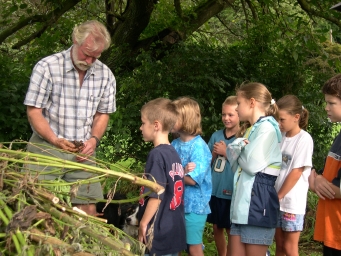 Fascinating Fireflies
By Kristy Deischer-Eddy
Fireflies, also known as lightning bugs or even glowworms, are familiar sights in the summertime. Did you know that they are actually beetles? While a true "fly" has one pair of wings (like houseflies), all other winged insects have two pairs of wings. As adults, fireflies are bioluminescent, meaning that they give off light without heat. Even as eggs, larvae or pupae, most firefly species are bioluminescent as well. Whether you call them flies or beetles or bugs, these creatures can be a great source of entertainment on a warm summer's evening.
 Fireflies can be found in warm, humid areas near water in Europe, Asia and the United States, east of the Rocky Mountains. The Pennsylvania Firefly ranges from Texas in the south to Manitoba in the north. With all the rain Chester County has received this year, it's no wonder the fireflies are in abundance here this summer!
Most firefly larvae are found in rotting wood or other forest litter, and they feed mostly on earthworms, snails and slugs. Larvae can detect a snail or slug slime trail, and follow it to the prey. After locating their future meal, they inject their prey with an anesthetic-like substance in order to immobilize and eventually digest it. This larval stage lasts one or two years. Fireflies can be found in warm, humid areas near water in Europe, Asia and the United States, east of the Rocky Mountains. The Pennsylvania Firefly ranges from Texas in the south to Manitoba in the north. With all the rain Chester County has received this year, it's no wonder the fireflies are in abundance here this summer!
Most firefly larvae are found in rotting wood or other forest litter, and they feed mostly on earthworms, snails and slugs. Larvae can detect a snail or slug slime trail, and follow it to the prey. After locating their future meal, they inject their prey with an anesthetic-like substance in order to immobilize and eventually digest it. This larval stage lasts one or two years.
Adult fireflies also have long, sickle-shaped mouths suggestive of predation; however, it is more likely that fireflies feed on plant nectar in order to sustain their energy requirements in the adult stage, which can last several months or longer.
Basically, fireflies produce light by a chemical reaction between substances found within the firefly and oxygen. There are several theories on how fireflies control the "on" and "off" switches of their luminescence. The "Oxygen Control Theory" is based on the firefly's control of the oxygen supply to its photic organ. The "Neural Activation Theory" hypothesizes that fireflies have neural control of certain cells, which, when stimulated, initiate the chemical reaction. Researchers believe that the pattern of fireflies' flashes has to do with mating rituals, with each species having a distinctive pattern. One thing is sure — the amount of flashing correlates to the intensity of ambient light. This is why you don't see many fireflies flashing on clear nights when the moon is full.
Regardless of how fireflies control the "on" and "off" of their bioluminescence, the production of light in the above manner is very efficient. While 100% of the fireflies' energy expenditure for each flash is visible as light, only 10% of a light bulb's energy is given off as light, the rest is released as heat.
If you're interested in attracting fireflies to your property, you'll need to eliminate the use of chemical on your lawn, minimize extraneous lighting (which interferes with mating), and encourage overhanging trees, tall grass, or similar vegetation that provides adult fireflies a place to rest and remain cool during the heat of the day.
Then as evening comes, sit back and watch the light show! If you want to grab a bug bucket or jar with vent holes, you can chase after these fascinating insects and maybe catch enough to light your room for a short while. Just be sure to release them when you're done.
Sources:
The "Firefly Files" online by The Ohio State University: http://iris.biosci.ohio-state.edu/projects/FFiles/frfact.html
Funk & Wagnalls New Encyclopedia, volume 10. New York: Funk & Wagnalls, Inc., 1979.
National Audubon Society's Field Guide to Insects and Spiders, Lorus and Margery Milne, Alfred A. Knopf, New York, 1980.
Conservation Corner
By Amy Bruckner
Land Preservation Options for Landowners — No. 3 of 3
What options are available to property owners interested in preserving their land? Well, there are plenty of options and surely there is an attractive option for every situation.
In the last two newsletters, I discussed the donation of Conservation Easements. I mentioned Bill H.R. 7, which would increase the amount of charitable deductions to up to 50% of the landowner's gross annual income. Unfortunately, the Bill has not yet passed, but it is still being reviewed by Congress.
A couple of other options are the sale of development rights and the sale of agricultural easements. Development rights may be sold, in the right situation, to the township, the county or even to a developer, who might transfer those development rights from a "sending zone," where the township wants to restrict development, to a "receiving zone," such as a borough, where more development would be accepted. In any case, in exchange for restricting the development of the land in perpetuity, the landowner could receive payment equal to the difference between the value of the land to a developer and the value of the land as open space, which could be a substantial sum. In Chester County, agricultural easements, which require the land to be used in perpetuity specifically for agricultural purposes, are overseen by the county Agricultural Land Preservation Board (ALPB). Application to both state and local agricultural easement programs is very competitive and the ALPB ranks applications, presents offers to the highest ranking landowners and submits its choices to the state for funding approval. The Northern Chester County Challenge Grant Program targets easement acquisitions in northern portions of the county where voters in local municipalities have approved bond issues to provide funds to match the state and county programs. Minimum state-designated criteria involve property size, proximity to other open space parcels, location in an Agricultural Security Area, soil quality and extent of harvestable cropland. The local program criteria are more flexible, allowing for operations as small as 25 acres and forms of agriculture not allowed under the state program, such as equine activities.
Another option that incorporates a number of different strategies is the concept of limited development. The strategies that might be used include:
- Donation of a conservation easement
- Donation of an open space parcel in fee simple to a land trust
- Gifts of approved building lots to children or grandchildren if the value is below the gift tax threshold
- Retention of a lot with the family homestead so the landowner can remain in their home and sell other lots adjacent to the open lands.
In many situations, minimal development on a parcel of land along with the tax benefits from charitable contributions can produce as much value for a landowner as outright sale of the parcel for conventional development. The integrity of the land is preserved, building in environmentally sensitive land is avoided and the few sites left available for houses are usually more valuable than conventional development house sites.
|
|
If you have received this Newsletter, consider it an invitation to please join us for the
Annual Picnic
For Friends, Members and Volunteers
Of the CSA
At Maysie's Farm Conservation Center
Beginning at 4:00 pm
On Saturday September 11th, 2004
(raindate: Sunday, September 12th)
Sign up in the barn or
RSVP to Sam at (610)458-8129 or
Sam@maysiesfarm.org
Please bring a dish to share
Think Globally, Eat Locally, Party at the Farm
|

Children learn about compost at the Down to Earth
Gardening workshop held on August 5, 2004. |

Louise Smith and Greta Cain, who first met
several years ago as CSA members,
always set aside some time to spend
together on their Friday pickups. |
|




